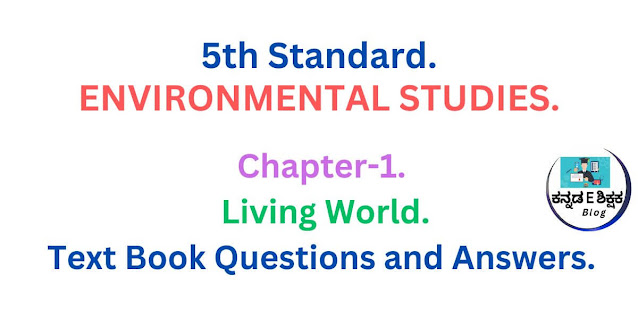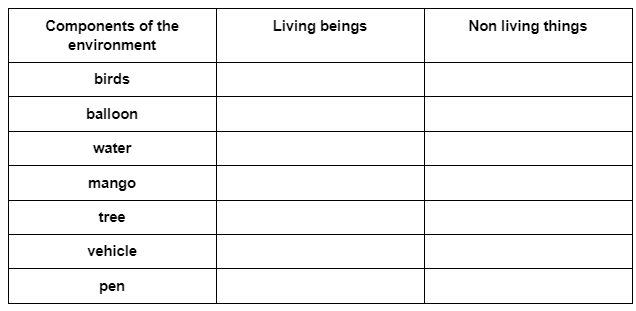KSEEB Solutions for Class 5 EVS Chapter 1 Living World.
The protection of the environment is the duty of all. You must have heard this saying. The word environment is very familiar to us. The thing around us is the environment. We can enjoy the environment by seeing only. We see hills, forests, rivers, falls, streams, honey bees, insects, eagles, snakes, soil, light, birds and so many other things around us that make us wonder. This is our environment. Our environment is home to diversity. You have the curiosity to know the specialty of this diversity. In this blog post, KSEEB Solutions for Class 5 EVS Chapter 1 Living World sample answers to questions asked in the chapter and answers to frequently asked questions in this chapter are given, we feel these answers will be helpful in your exam preparation. Living World Class 5 is a very important chapter all of you have to concentrate thank you.
KSEEB Solutions for Class 5 EVS Chapter 1 Living World.
1. In the following chart some components of the environment as well as. some of the living characteristics are given. Read carefully. If in each of the components, the characteristics given in front of them are found, mark the (✓) sign. If these characteristics are not found mark (✗) sign.
Answer-
Some of the components seen in the environment are given below. Identify them as living beings or nonliving things. Put (✓) mark in front of the correct choice.
Answer-
Living Beings- Man, plants, snakes, cow, dogs, lions, ants.
Non-Living Things- pen, pencil, book, plate, rock, water.
Observe the given picture. Identify the picture and write it here.
Preparation of food in plants' atmosphere carbon dioxide solar energy water, minerals, salts chlorophyll Observes the picture. Four important components needed to produce food by the plants are given. An activity, Which? From what? is given below. Join the statements correctly and write.
Answer-
In the preparation of food by the plants, glucose is produced
and oxygen is released. Write here, the uses of these two for living beings.
1. glucose _____________________________________________
2. oxygen _______________________________________________
1. glucose: It is used in respiration to release energy.
2. Oxygen: Used for respiration by plants and animals.
Observe the pictures given below. How do these plants obtain their food?
Answer-Insectivorous means insect-eating, these plants derive most of their nutrition from the insects, that they trap and consume. These plants grow in humid areas, where plenty of sunlight and moisture are found. They are found in nitrogen-deficient soil. That is why they trap and digest insects to absorb nutrients. Example- Drosera, Nepenthes, Utrieularia Plants
With the help of these pictures list out herbivores, carnivores, and omnivores in the chart below. 
living world class 5
Certain statements related to growth are given below. If the statements are correct put the (✓) mark, if not put the (✗)mark. Correct the incorrect statements and write.
∗ All organisms are small at the time of birth but later acquire definite height and size. (✓)
∗ Growth takes place rapidly in one or two days. (✗)
Growth doesn't take place rapidly in 1 or 2 days.
∗ Plant growth is observed at its stem tip or the size of the stem.(✓)
Write their organs of movement here.
man ___________ eagle____________
kangaroo ___________ bat ____________
Man - Legs Eagle - wing
kangaroo - Legs Bat - wings
Why do animals move? Discuss in groups and write in the space given below.
Answer-Animals move around in search of food, shelter and to escape from predators or enemies.Given below are certain statements related to reproduction. If the statements are correct, put a (✓) mark. If the statements are wrong, put a (✗) mark. Answer-
Activity: List out the animals that lay eggs and those which directly give birth to young ones.
List of organisms that give birth through eggs-Chicken, Lizard, Pigeon, Crocodile.
List of organisms that directly give birth to young-Man, Dog, Cat, Elephant, Cow.
List out the plants that reproduce through seeds and stems
List of plants that reproduce by seeds
-Wheat, groundnut, mango, jackfruit,
List of plants that reproduce by stem
-Rose, hibiscus, sugarcane, cactus.
Write the uses of the plants given below
Annuals
1. _____________________________________________________
2. _____________________________________________________
Biennials
1. _____________________________________________________
2. _____________________________________________________
Perennials
1. _____________________________________________________
2. _____________________________________________________
1. Annual plants - food, fodder for animals.
2. Biennial plants -for commercial use, for food
3. Perennial plants: For commercial use, timber, and equipment manufacturing.
Activity: List out the national reserve forests, wildlife sanctuaries, and bird sanctuaries in Karnataka.
Adichunchanagiri Peacock Sanctuary.
Arabithittu Wildlife Sanctuary.
Bhadra Wildlife Sanctuary.
Bhimgad Wildlife Sanctuary.
BRT Wildlife Sanctuary.
Cauvery Wildlife Sanctuary.
Daroji Sloth Bear Sanctuary.
Gudekote Sloth Bear Sanctuary.
Kappathagudda Wildlife Sanctuary
Mookambika Wildlife Sanctuary.
FAQS- 5th evs living world additional questions and answers.
What is the environment?
Environment means the elements found around us. For example- hills, forests, rivers,
stream, bee, insects, eagle, snake, soil, light, birds.
2. What are the main characteristics of living things?
Important characteristics of organisms are-
Growth, food intake, movement, respiration, excretion, response to stimuli, and reproduction.
3. What are the benefits to organisms of energy from food?
Chopping wood, carrying heavy bags, hunting, etc., animals do many activities every day. Living things need the energy to do all these things.
4. What is photosynthesis?
Plants produce food by absorbing energy from sunlight, carbon dioxide in the atmosphere, water in the soil, and minerals through the roots and through the leaves in the leaves. This is called photosynthesis.
5. What are Insectivorous plants?
Dracira, Nepenthes, and Utricularia plants made their own food but depended on insects for nitrogen. These are called Insectivorous plants.
6. What are Herbivores?
Animals that eat only plants and their products.
Eg - cow, buffalo, deer, rabbit.
7. What are carnivores?
Animals that survive by eating other animals for their food eg tiger, lion, leopard, snake.
8. What are Omnivores ?
Animals that consume both plants and animals as food eg bears, cats, crows, man
9. What is growth?
An increase in height and size of organisms is called growth.
10. What is excretion?
Many activities take place in the body of an organism, due to which substances that the body does not need are produced. The process of removing these from the body is called excretion.
11. How do animals excrete waste in what form?
Animals excrete waste products in the form of carbon dioxide, sweat, feces, and urine. There are special organs for that.
12. How do plants excrete unwanted substances?
Plants also release carbon dioxide gas during respiration. Dry leaf, stem, and rotten parts are removed from the plants. Excess water is excreted by plants through leaves.
14. What is the lifespan?
Organisms are born, grow into adults, reproduce, and eventually die. Thus the period between the birth and death of an organism is called the life span.
15. How are plants classified on the basis of life span?
Plants are divided into annuals, biennials, and perennials on the basis of lifespan.
16. How are plants classified on the basis of plant seeds?
On the basis of the seeds of plants, plants are divided into cereal grains and legumes.
The seed of cereal grain plants consists of one seed pod.
Example: Maize, Millet, Wheat, Paddy, Cereals.
The seed of leguminous plants consists of two cotyledons.
Example: Beans, Legumes. Chickpea,
Class 5th EVS Chapter 1 Living World Solutions in Pdf.
Class 5th EVS Chapters Solutions in Kannada medium👇👇👇
5th class evs book pdf English medium KTBS. |



















PLEASE DO NOT ENTER ANY SPAM LINK IN THE COMMENT BOX